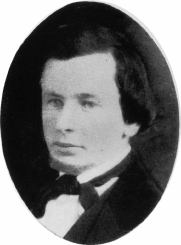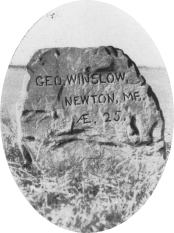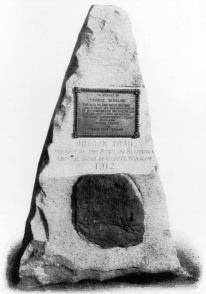|
By GEORGE W. HANSEN [Paper read at the annual meeting
of the Nebraska State Historical Society, January,
1912.] |
|
Nebraska State Historical
Society
|
||||
from the mountains. This took us until July 16, and was as far as we wished the wagons to go, as the furs to be brought in were to be collected at this place. On the fourth of August, the wagons being loaded with furs, we set out on the return to St. Louis. Our route back was over the same ground, nearly, as going out, and we arrived at St. Louis on the 10th of October. The usual progress was fifteen to twenty-five miles per day, the country being almost all open, level, and prairie. The chief obstructions were ravines and creeks, the banks of which required cutting down. "This is the first time that wagons ever went to the Rocky mountains . . . ." To William Sublette, then, belongs the honor of making the first wagon track over this historic road to the Rocky mountains.1 On the first of May, 1832, Captain Bonneville, with one hundred and ten men, "some of whom were 1 The letter, a part of which is here restated, is a report to the secretary of the treasury signed by Jedediah S. Smith, David E. Jackson, and William L. Sublette, in the order named. Smith and Jackson, however, remained in the hunting grounds during the winter of 1829 while Sublette returned to St. Louis for an outfit for their new rendezvous in Pierre's Hole. They were partners and all celebrated traders and trappers in the Rocky mountain region. Their report is published as document 39, Senate Executive Documents, 2d session 21st congress, pp. 21-23, and in the Quarterly of the Oregon Historical Society, December, 1903, page 395. Their statement that the wagons of this expedition were the first that ever went to the Rocky mountains is erroneous. There were three wagons in William Bicknell's expedition of 1822, which passed up the Arkansas river to the mountains and thence south to Santa Fe. Numerous wagon trains passed over the trail to Santa Fe--which is situated at the southern extremity of the Rocky mountain range by that name-between 1822 and 1830. One of these trains, in 1824, contained twenty-five wagons. So far as is known, Smith, Jackson and Sublette's wagons were the first to reach the Rocky Mountains over the route which came to be known as the Oregon trail about fifteen years later; but William H. Ashley took a mounted cannon to and beyond the mountains, presumably over this route, in 1826. This is regarded as the first vehicle on wheels to cross the plains to the mountains north of the Santa Fe Trail, because there is no proof or knowledge to the contrary. The statement in the report as to the place where the wagons were taken is hopelessly confused. "The head of Wind River, . . . as far as |
experienced hunters and trappers," and a train of twenty wagons left Fort Osage--about twenty-two miles below the mouth of the Kansas river--arrived at the crossing of the Kansas on the 12th, reached Grand Island, about twenty-five miles below its head, on the 2d of June, and Green river on the 27th of July.2 The same year came William Sublette, a partner in the Rocky Mountain Fur Company, in command of a party of sixty men carrying merchandise to the annual rendezvous of the company in the Wind river valley. At Independence, Missouri, he took under his care a party of New Englanders, fitted out and commanded by we wished the wagons to go," is a hundred miles north of "the Southern Pass, where the wagons stopped . . ." Chittenden (History of the American Fur Trade, v. 1, p. 292, note) forces a guess that the authors of the report mistook the Popo Agie, whose headwaters are only fifteen miles from the South Pass, for the Wind river. But the head of the Popo Agie is about forty miles from the nearest point of the Wind river--too far, it would seem, to be mistaken for the main stream with which all three of the partners must have been familiar, since they had followed it to, or crossed it near its head, the year before, on their way to Jackson's Hole and Pierre's Hole. Only two years later than the date of the report Captain Bonneville shows that the Popo Agie and the Wind river were distinctively known. (The adventures of Captain Bonneville, pp. 235, 237.) Still, if Smith, Jackson and Sublette's statement is to be regarded at all it must be assumed that they called Wind river the Popo Agie. Irving--in his Captain Bonneville--appropriately calls the Popo Agie the head of the Big Horn which is a direct continuation of it; but now the name Big Horn is applied to the river beyond the junction of the Wind and the Popo Agie, which occurs in Fremont county, Wyoming. Coutant's History of Wyoming (v. 1, p. 132) says that the rendezvous was at the mouth of the Popo Agie--which is fifty miles northwest of South Pass--and that the wagons were taken to the Wind river valley, that is to the rendezvous itself, which seems the most likely theory, though, unfortunately, no authority is given for it.--ED. 2 The Adventures of Captain Bonneville (Lippincott, 1871) pp. 39, 44, 51, 79. Bonneville was granted leave of absence by the war department to explore "the territory belonging to the United States between our frontier and the Pacific." (Ibid., p. 502.) Pierre's Hole, the rendezvous of the Rocky Mountain Fur Company, was his immediate objective. (Ibid., P. 41) The Columbia river region did not then belong to the United States.--ED. |
Nathaniel J. Wyeth, whose name was given to a small creek now called Rock creek, in Jefferson county, Nebraska.3 In the year 1842, on the evening of the 22d day of June, John C. Fremont, his guide, Kit Carson, and ordinary employees--in all twenty-seven or twenty-eight,4 including the son of Senator Benton--made their bivouac at the same cold spring, by the side of which, seven years later, George Winslow died. The Fremont party took their mid-day meal at Wyeth's creek, a few miles east of the present town of Fairbury, and "John C. Fremont," "Christopher Carson," and "1842", are carved on a rocky face of its bank. Fremont had no difficulty in following this path, for, as he says, "about three weeks in advance of us was Doctor Elijah White with a party of sixteen or seventeen families, one hundred and twenty-seven people in all, in heavy wagons on their way to Oregon." This caravan was the earliest organized home-seeking overland emigration to Oregon. 5 3 Authorities generally agree that the number in Sublette's party was sixty-two. (Wyeth's Oregon, p. 47; History of the Northwest Coast, v. 2, p. 561.) John Ball says in his journal of the expedition that it followed the Big Blue and crossed over from its source to the Platte, and his estimate of distances agrees with this statement; but other circumstances indicate, though not conclusively, that he miscalled the Little Blue the Big Blue.--ED. 4 The uncertainty arises from the fact that Fremont gives the number of his ordinary employees as twenty-one while his list of them contains twenty-two names. Randolph Benton was a lad of twelve years.--ED. 5 The author has a standard authority--F. G. Young, Quarterly of the Oregon Historical Society, December, 1900, page 350--for his statement of the total number of the colony; but estimates vary greatly. The total number is commonly put at one hundred and twenty. (History of the Pacific Northwest, p. 175; Quarterly of the Oregon Historical Society, December, 1905, p. 386.) Eells in his "Marcus Whitman" (p. 125) says the number was "about a hundred and ten." In "Ten Years in Oregon" (p. 144), virtually Doctor White's autobiography, it is said that "additions were made to the party till it amounted to one hundred and twelve persons." Medorem (also variously spelled in the books Medorum, Medoram, etc.) Crawford, a member and historian of the expedition, gives the number as one hundred and five, and Gray (History of Oregon, p. 212) says that there were forty-two families and one hundred and eleven persons. The 9 |
In June, 1844, Doctor Marcus Whitman, pursuant to a request of the secretary of war, drafted a bill providing for the establishment of posts along the road to Oregon for the protection of emigrants. The first section of this bill provided that these posts should be established beginning at the present most usual crossing of the Kansas river, thence ascending the Platte on the southern boundary thereof. In his brief, Doctor Whitman suggested the crossing of the Blue, the Little Blue, and the junction of the road with the Platte as sites for such posts. He says: "I have, since our last interview, been instrumental in piloting across the route described in the accompanying bill, and which is the only eligible wagon road, no less than two hundred families, consisting of one thousand persons of both sexes, with their wagons, amounting in all to more than one hundred and twenty with six hundred and ninety-four oxen and seven hundred and seventy-three loose cattle. As pioneers, these people have established a durable road from Missouri to Oregon, which will serve to mark permanently the route for larger numbers each succeeding year.6 highest number of any authority is one hundred and sixty. See History of Oregon (Bancroft), v. 1, p. 256, footnote. It is there said that there were one hundred and twelve in the original organization which was increased on the road to one hundred and twenty-five.--ED. 6 The number of people and animals in this great expedition cannot be given accurately since they vary in the best accounts of it; but those here given are approximately correct. Dr. Whitman's statement that he piloted the expedition is misleading. Though, by common consent, his services as guide were of great value, yet he did not join the colony until the Platte river was reached, and he left it at Fort Hall to go in advance to the Columbia river--over the least known and probably most difficult part of the road. In "A Day with the Cow Column in 1843" (Quarterly Oregon Historical Society, page 381), Jesse Applegate, a member of the colony, and afterwards very prominent in Oregon, said: "From the time he joined us on the Platte until he left us at Fort Hall, his great experience and indomitable energy were of priceless value to the migrating column." In his" Marcus Whitman" (page 222) Eells, a strong partisan of Whitman's, explains why he left the expedition at Fort Hall. Doctor Whitman's bill provided for establishing "a chain of agricultural posts or farming stations", |
During the summers of 1844 and 1845 eight hundred wagons, with four thousand people, traveled over the Trail from Independence to the Columbia. In June, 1846, over three thousand people, with five hundred wagons, were upon the trail. In 1847 the high water-mark in the Oregon migration of the first decade was reached, five thousand people with eight hundred wagons making the journey. The California gold fever became epidemic in 1849 and 1850, and in those years vast numbers of emigrants passed Winslow's grave.7 Following the clue of the headstone, last summer I met George Winslow's sons, George E., of Waltham, Mass., and, as he describes their purpose, they would have been truly pioneer agricultural experiment stations, with military equipment also.--ED. 7 Many estimates of the amount of travel over the Trail have been published--some careful, some careless and none, possibly, quite accurate. Horace Greeley, who went to California by the overland route in 1859, estimates that thirty thousand people went over the road that year; and it appears that a third of them were bound for Oregon. (Bancroft's History of Oregon, v. 2, p. 465, note.) The Oregon emigration was as high as ten thousand in 1862 also. (Ibid., p. 493; History of Wyoming, Coutant, p. 379.) For estimates of emigration to Oregon, 1842-1862, by F. G. Young, see Quarterly Oregon Historical Society, December, 1900, p. 370. For estimates of emigration for 1844, 1845 and 1846, see Bancroft's History of Oregon, v. 1, pp. 446-572. The total overland emigration to the Pacific Coast in 1846 was 2,500. Bancroft (Ibid., p. 108) and The History of the Pacific Northwest (p. 209) say that the emigration of 1845 was three thousand, doubling the population, and greater than any that had preceded it. A conservative estimate of the number of emigrants passing over the South Pass in 1849 puts it at 25,000, and in 1850, 40,000. (History of California--Bancroft--, v. 6, p. 159; v. 7, p. 696.) Major Osborne Cross, who went to Oregon in 1849 with the Mounted Rifles regiment, estimated the total number of overland emigrants to California that year at thirty-five thousand, a considerable part of whom took the Santa Fe route. He remarked that few of those on the upper route went to Oregon. (Senate Executive Documents, 1850-51, v. 1, doc. 1, p. 149.) F. G. Young estimated the number going to Oregon at only four hundred. (Quarterly of the Oregon Historical Society, December, 1900, p. 370.) According to the same authority--ibid., p. 354--"after 1850 the Council Bluffs route had the largest transcontinental travel." The number going by the Council Bluffs route in 1849 and in 1860 and by the minor routes between that place and the eastern terminus of the trail would reduce the number passing up the Little Blue in the two years far below the total of 65,000 overland passengers.--ED. |
and Henry O., at the home of the latter in Meriden, Conn. They were intensely interested in the incident of their father's death and in the protection of his grave. Henry Winslow will himself fashion a bronze tablet for the marker to be erected by the state of Nebraska. I learned from them that George Gould, the last survivor of the party, lives at Lake City, Minn. I now present to this society a daguerreotype portrait of him, taken in 1849, and a recent photograph; also his diary covering the entire journey. From the Winslow memorial published in 1877, a copy of which I found in the Winslow home, and also in the New York city public library, we learn that George Winslow was descended from Kenelm Winslow of Droitwitch, England, whose two sons, Edward and Kenelm, emigrated to Leyden, Holland, and joined the Pilgrim church there in 1617. Edward came to America with the first company of emigrants in the Mayflower and was one of the committee of four who wrote the compact or magna charta, which was subscribed to by all before landing. He became governor of Plymouth colony in 1833. His brother Kenelm came to America in the Mayflower with the longhindered remainder of the Pilgrim church on a later voyage. His son, Kenelm Winslow, was born at Plymouth, Massachusetts, in 1635, and became the owner of large tracts of land. He bought a thousand acres at Mansfield, Connecticut for one hundred and fifty dollars. He was fined ten shillings for riding a journey on the Lord's day, although he pleaded necessity and that it was not want of respect for religion, for on three occasions he went sixty miles that his children might not remain unbaptized. His son Josiah, born 1669, established the business of cloth dressing at Freetown, Massachusetts. He was a captain in the Massachusetts militia. His son James, born 1712, continued his father's business, and was a colonel in the Second regiment, Massachusetts militia. His |
 |
 |
 |
 |


